A Prediction Method for the Average Winding Temperature of a Transformer Based on the Fully Connected Neural Network
Abstract
:1. Introduction
2. Analysis of the Thermal Properties of Oil-Immersed Transformers
2.1. Internal Heat Generation Mode of Oil-Immersed Transformer
2.2. Internal Heat Transfer Process of Oil-Immersed Transformer
3. Prediction of AWTT
3.1. Correlation Analysis of Original Variables
3.2. Factor Analysis Feature Dimension Reduction
3.3. Constructing Fully Connected Neural Networks
3.4. Prediction Method for AWTT
4. Case Verification
4.1. Field Test
4.2. Data Preprocessing
- (1)
- The component matrix after rotation is shown in Table 5. Obviously, the first common factor corresponds to a larger value in terms of ambient temperature and top oil temperature, while the second common factor is associated with a higher value of load current compared to the other two factors, which better represents the characteristic parameter of load current. Therefore, the first common factor is known as temperature factor f1, and the second common factor is known as load factor f2. These factors primarily represent the temperature variables and load variables that impact the temperature rise characteristics of the transformer.
4.3. Case Verification
- (1)
- Parameter setting:
- (2)
- Results analysis:
- (3)
- Comparative analysis
5. Discussion and Conclusions
- (1)
- After factor analysis is adopted, the coupling among ambient temperature, load current, and top oil temperature can be effectively removed. Two key parameters, the temperature factor and load factor, are proposed to reduce the complexity of the network model, which reduces the amount of data input and improves the efficiency;
- (2)
- The prediction model based on factor analysis and a fully connected neural network can accurately obtain the AWTT. The RMSE between the predicted results and the measured values of the AWTT is 0.62498, and the R2 is 0.9714, which shows the feasibility of the proposed method;
- (3)
- Compared with the thermal circuit guideline method, the L-M method and the method without factor analysis, the results show that the prediction method proposed in this paper has higher accuracy and reliability. Combined with the predicted results, the abnormal values can be removed and corrected to make the AWTT prediction more accurate, which is of great significance for the prediction of the winding hot-spot temperature and transformer state assessment.
Author Contributions
Funding
Institutional Review Board Statement
Informed Consent Statement
Data Availability Statement
Conflicts of Interest
Abbreviations
| P | the copper loss |
| the phase current of the primary transformer windings | |
| the phase current of the secondary transformer windings | |
| the total resistance of the primary transformer windings converted to 75 °C | |
| the total resistance of the secondary transformer windings converted to 75 °C | |
| P0 | the iron loss |
| K0 | the loss technological coefficient |
| G | the core weight |
| Pc | the loss per unit weight |
| P1/50 | the iron loss coefficient |
| the frequency index | |
| s | covariance |
| the standard deviations of variables X | |
| the standard deviations of variables Y | |
| the average values of X | |
| the average values of Y | |
| n | the number of samples |
| the common factor | |
| the coefficient of the i th factor corresponding to the j th variable | |
| , , | the three original variables after standardization |
| R2 | goodness of fit |
| y | the measured value |
| the predicted value | |
| the average value | |
| S | the surface area |
| h | the convective heat transfer coefficient |
| TW | the outer surface temperature of the transformer tank |
| TH | the ambient temperature |
| the Stephen–Boltzmann constant | |
| E | the surface radiation coefficient |
References
- Yuan, F.T.; Yang, W.T.; Han, Y.L. Temperature Rise Calculation and Structure Optimization Research of Transformer Winding Based on Electromagnetic-fluid-thermal Coupling. High Volt. Eng. 2024, 50, 952–961. [Google Scholar]
- Yao, S.; Hao, Z.; Si, J.; Zhang, Y. Dynamic deformation analysis of power transformer windings under multiple short-circuit impacts. In Proceedings of the IEEE 8th International Conference on Advanced Power System Automation and Protection (APAP), Xi’an, China, 21–24 October 2019; pp. 1394–1397. [Google Scholar]
- Qiu, Z.; Ruan, J.; Huang, D.; Wei, M.; Tang, L.; Huang, C.; Xu, W.; Shu, S. Hybrid prediction of the power frequency breakdown voltage of short air gaps based on orthogonal design and support vector machine. IEEE Trans. Dielectr. Electr. Insul. 2016, 23, 795–805. [Google Scholar] [CrossRef]
- Ni, Z.Z.; Luo, Y.T.; Jiang, J.F. Multi-timescale Prediction of Transformer Top Oil Temperature Based on Adaptive Extended Kalman Filter. Power Syst. Technol. 2024, 1–11. [Google Scholar]
- Wang, L.J.; Zhou, L.J.; Yuan, S. Improved dynamic thermal model with pre-physical modeling for transformers in ONAN cooling mode. IEEE Trans. Power Deliv. 2019, 34, 1442–1450. [Google Scholar] [CrossRef]
- Li, H.; Liu, Y.P.; Wang, J.X. Analysis and Test Verification of Dynamic Thermal Model of Oil-immersed Distribution Transformer. Proc. CSEE 2023, 43, 389–399. [Google Scholar]
- Farzin, N.; Vakilian, M.; Hajipour, E. Practical implementation of a new percentage-based turn-to-turn fault detection algorithm to transformer digital differential relay. Int. J. Electr. Power Energy Syst. 2020, 121, 106158. [Google Scholar] [CrossRef]
- Sönmez, O.; Komurgoz, G. Determination of hot-spot temperature for ONAN distribution transformers with dynamic thermal modelling. In Proceedings of the 2018 Condition Monitoring and Diagnosis (CMD), Perth, Australia, 23–26 September 2018; pp. 1–9. [Google Scholar]
- C57.91-2011; IEEE Guide for Loading Mineral-Oil-Immersed Transformers and Step-Voltage Regulators. IEEE: Piscataway, NJ, USA, 2011.
- IEC 60076-7: 2018; Power Transformers-Part 7: Loading Guide for Mineral-Oil-Immersed Power Transformers. American National Standards Institute (ANSI): New York, NY, USA, 2018.
- Swift, G.; Molinski, T.S.; Lehn, W. A fundamental approach to transformer thermal modeling. I. Theory and equivalent circuit. IEEE Trans. Power Deliv. 2001, 16, 171–175. [Google Scholar] [CrossRef]
- Nordman, H.; Rafsback, N.; Susa, D. Temperature responses to step changes in the load current of power transformers. IEEE Trans. Power Deliv. 2003, 18, 1110–1117. [Google Scholar] [CrossRef]
- Liao, C.B.; Ruan, J.J.; Lu, H.D. 2-D Coupled Electromagnetic-fluid-thermal Analysis of Oil-immersed Transformer. Sci. Technol. Eng. 2014, 14, 67–71. [Google Scholar]
- Wang, Y.Q.; Ma, L.; LV, F.C. Calculation of 3D Temperature Field of Oil Immersed Transformer by the Combination of the Finite Element and Finite Volume Method. High Volt. Eng. 2014, 40, 3179–3185. [Google Scholar]
- Li, T.; Sun, X.W.; Du, X.P. Simulation Analysis of Transformer Flow Field and Temperature Field Based on Finite Element Method. Autom. Instrum. 2020, 35, 1–5+10. [Google Scholar]
- Li, K.J.; Qi, X.W.; Wei, B.G. Prediction of Transformer Top Oil Temperature Based on Kernel Extreme Learning Machine Error Prediction and Correction. High Volt. Eng. 2017, 43, 4045–4405. [Google Scholar]
- Li, K.J.; Xu, Y.S.; Wei, B.G. Prediction Model for Top Oil Temperature of Transformer Based on Hybrid Kernel Extreme Learning Machine Trained and Optimized by Particle Swarm Optimization. High Volt. Eng. 2018, 44, 2501–2508. [Google Scholar]
- Zhang, Y.Y.; Wei, X.X.; Fan, X.H.; Wang, K.; Zhuo, R. A Prediction Model of Hot Spot Temperature for Split-Windings Traction Transformer Considering the Load Characteristics. IEEE Access 2021, 9, 22605–22615. [Google Scholar] [CrossRef]
- Yang, J.J.; Zhang, G.; Liu, Y.F.; Gong, Z.F.; Liu, Z.G. A method for calculating hot-spot temperature of traction transformer based on multi-physical model and combined neural network. IEEE Trans. Transp. Electrif. 2023. [Google Scholar] [CrossRef]
- Wei, B.G.; Wu, X.Y.; Yao, Z.F.; Huang, H. A method of optimized neural network by L-M algorithm to transformer winding hot spot temperature forecasting. In Proceedings of the IEEE Electrical Insulation Conference (EIC), Baltimore, MD, USA, 11–14 June 2017; pp. 87–91. [Google Scholar]
- Peng, D.G.; Chen, Y.W.; Qian, Y.L.; Huang, C. Transformer Winding Temperature Soft Measurement Model Based on Particle Swarm Optimization-Support Vector Regression. Trans. China Electrotech. Soc. 2018, 33, 1742–1749. [Google Scholar]
- Chegsakul, T.; Tayjasanant, T. An impact of harmonic currents, load levels and ambient temperatures on transformer loss of life. J. Phys. Conf. Ser. 2019, 1311, 012047. [Google Scholar] [CrossRef]
- Luo, C.; Zhao, Z.G.; Wang, Y.Y.; Liang, K.; Zhang, J.H.; Li, Y.N.; Li, C. Influence of insulation paper on the hot spot temperature of oil-immersed transformer winding. Mod. Phys. Lett. B 2022, 35, 2140021. [Google Scholar] [CrossRef]
- Gorgan, B.; Notingher, P.V.; Wetzer, J.M.; Verhaart, H.F.A.; Wouters, P.A.A.F.; Van Schijndel, A. Influence of solar irradiation on power transformer thermal balance. IEEE Trans. Dielectr. Electr. Insul. 2012, 19, 1843–1850. [Google Scholar] [CrossRef]
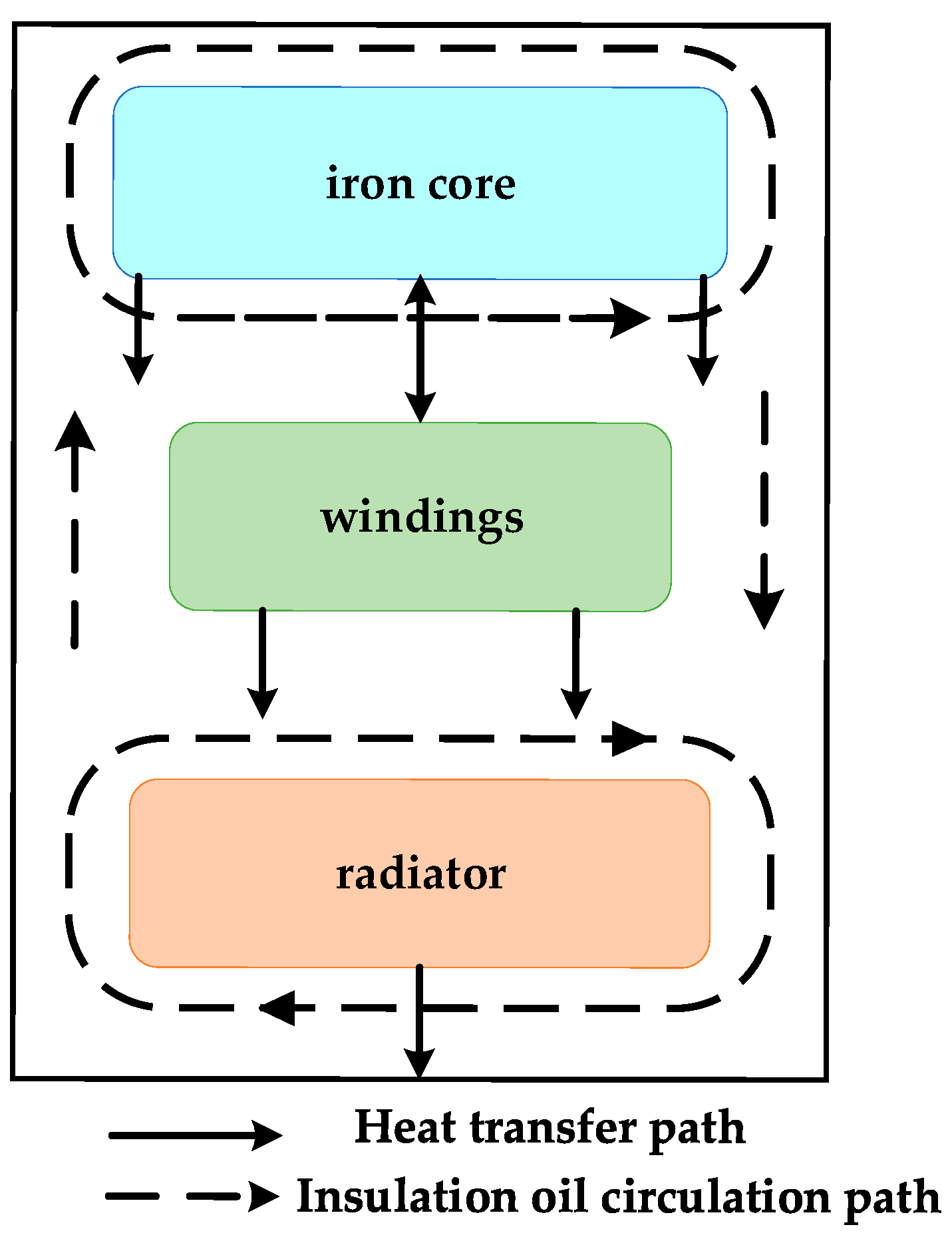
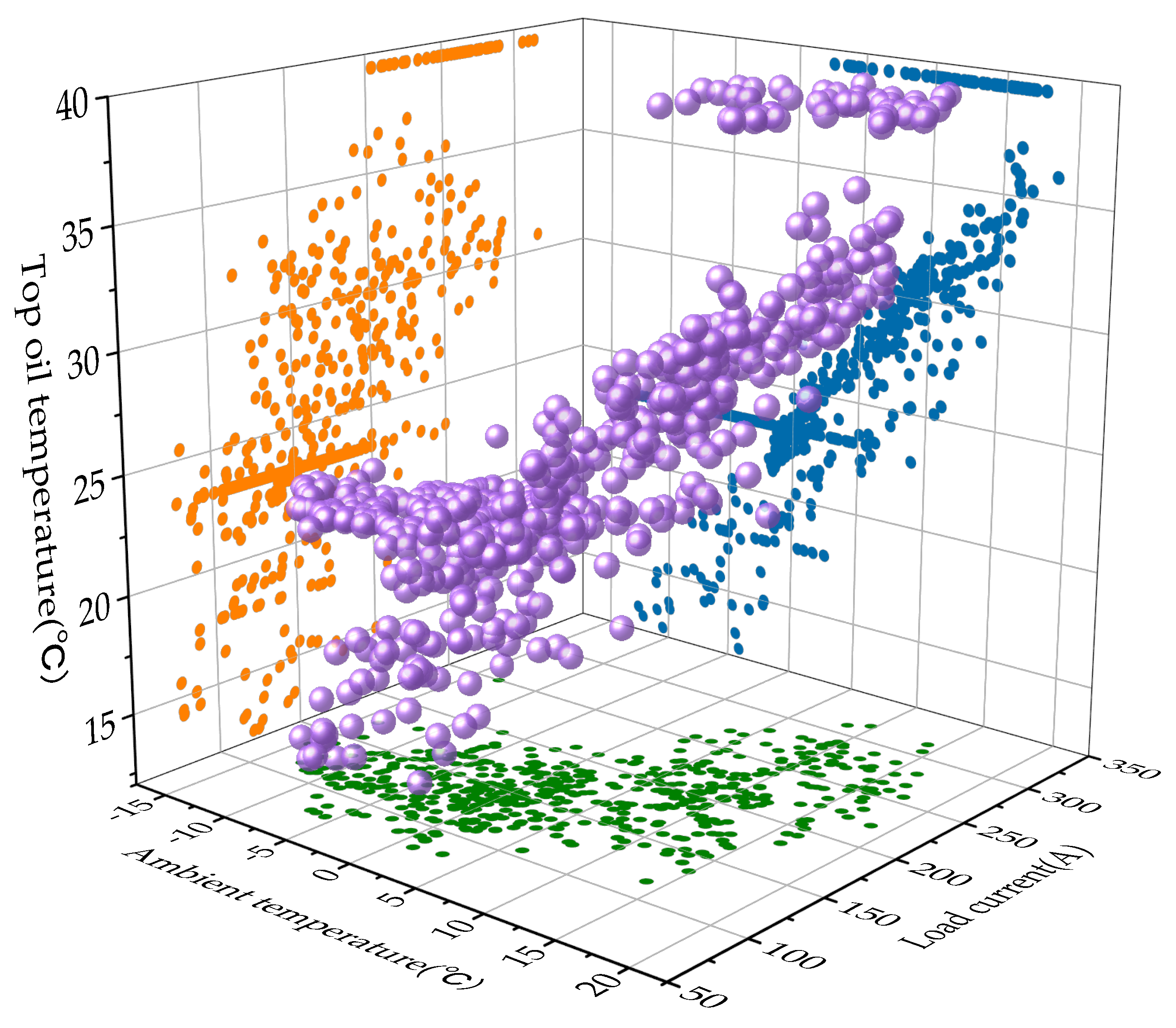
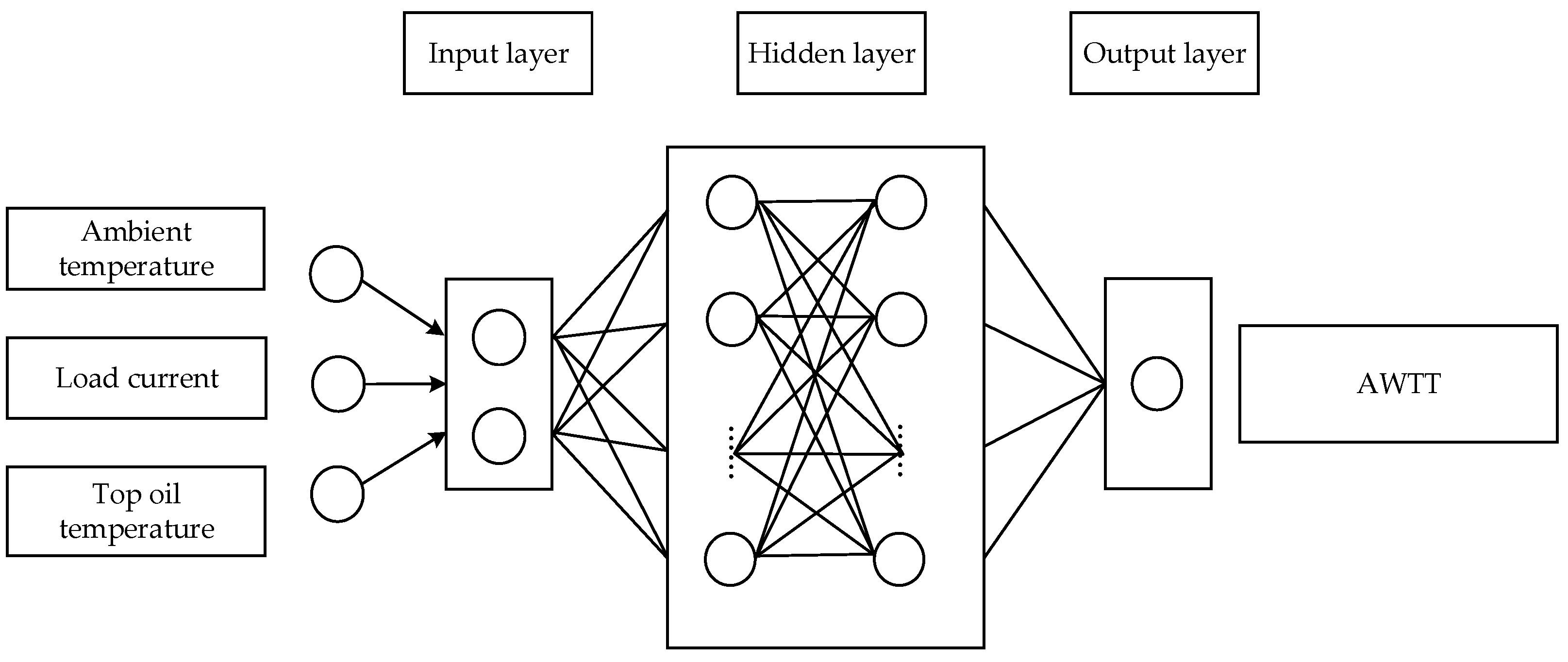
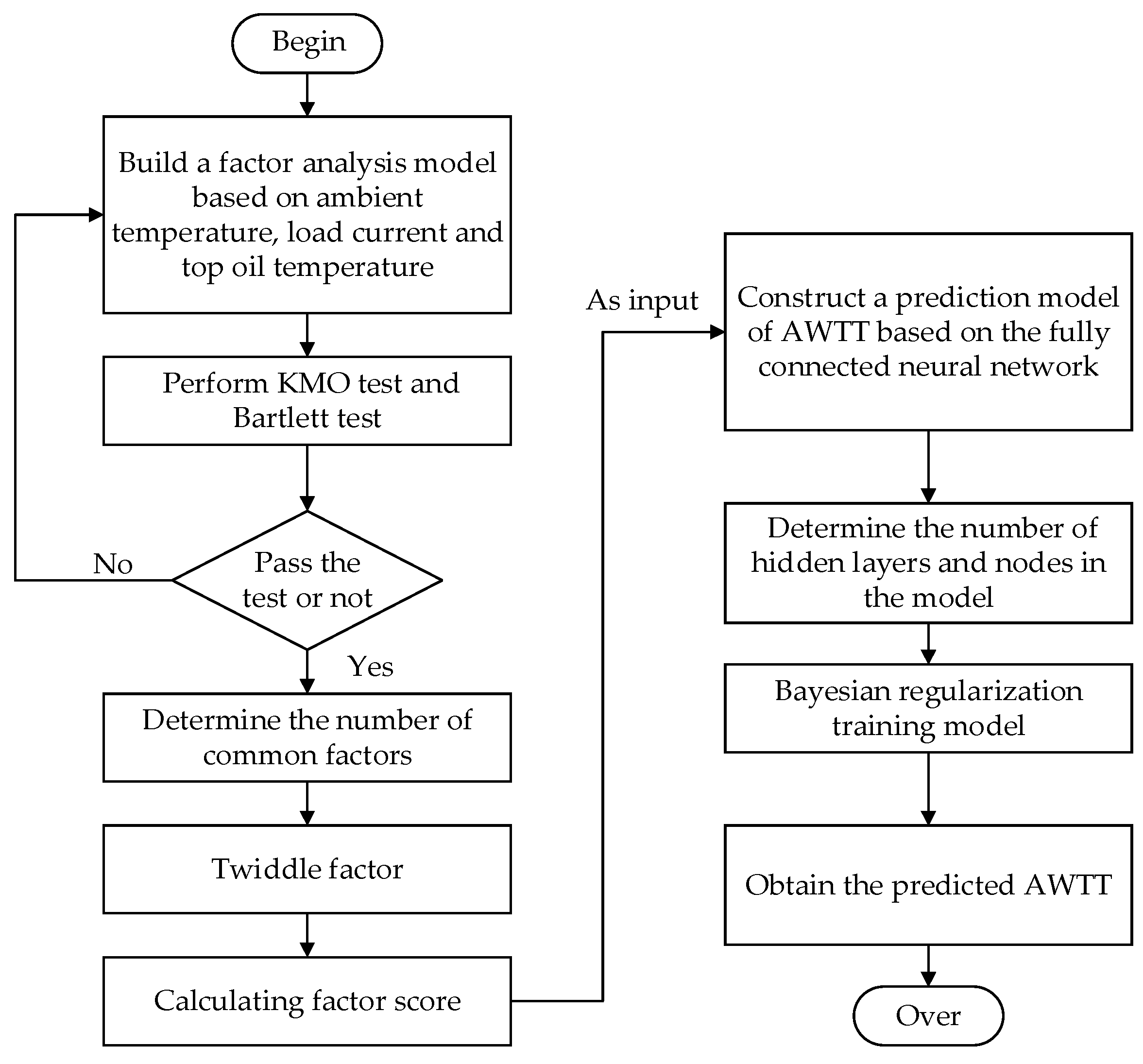

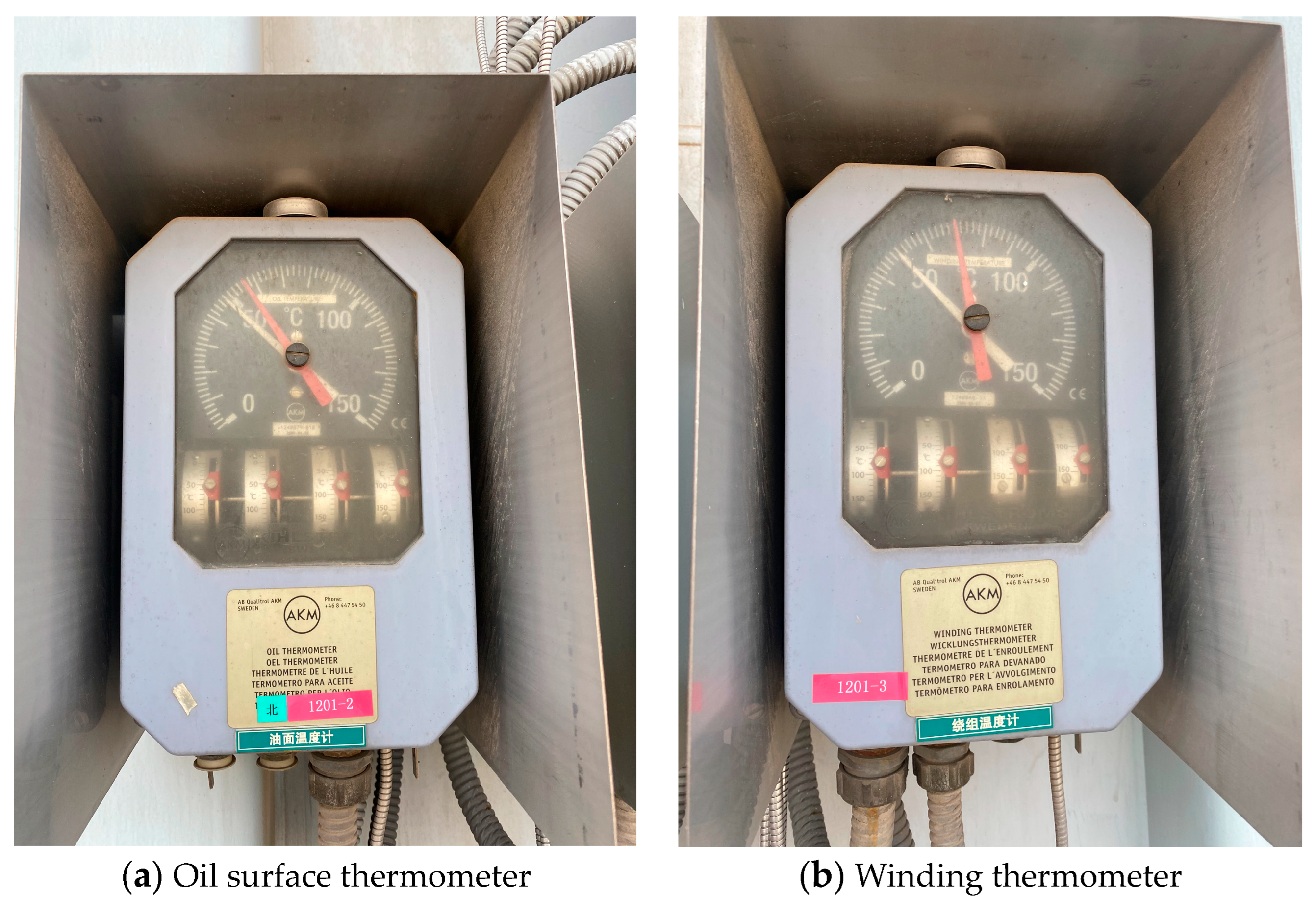
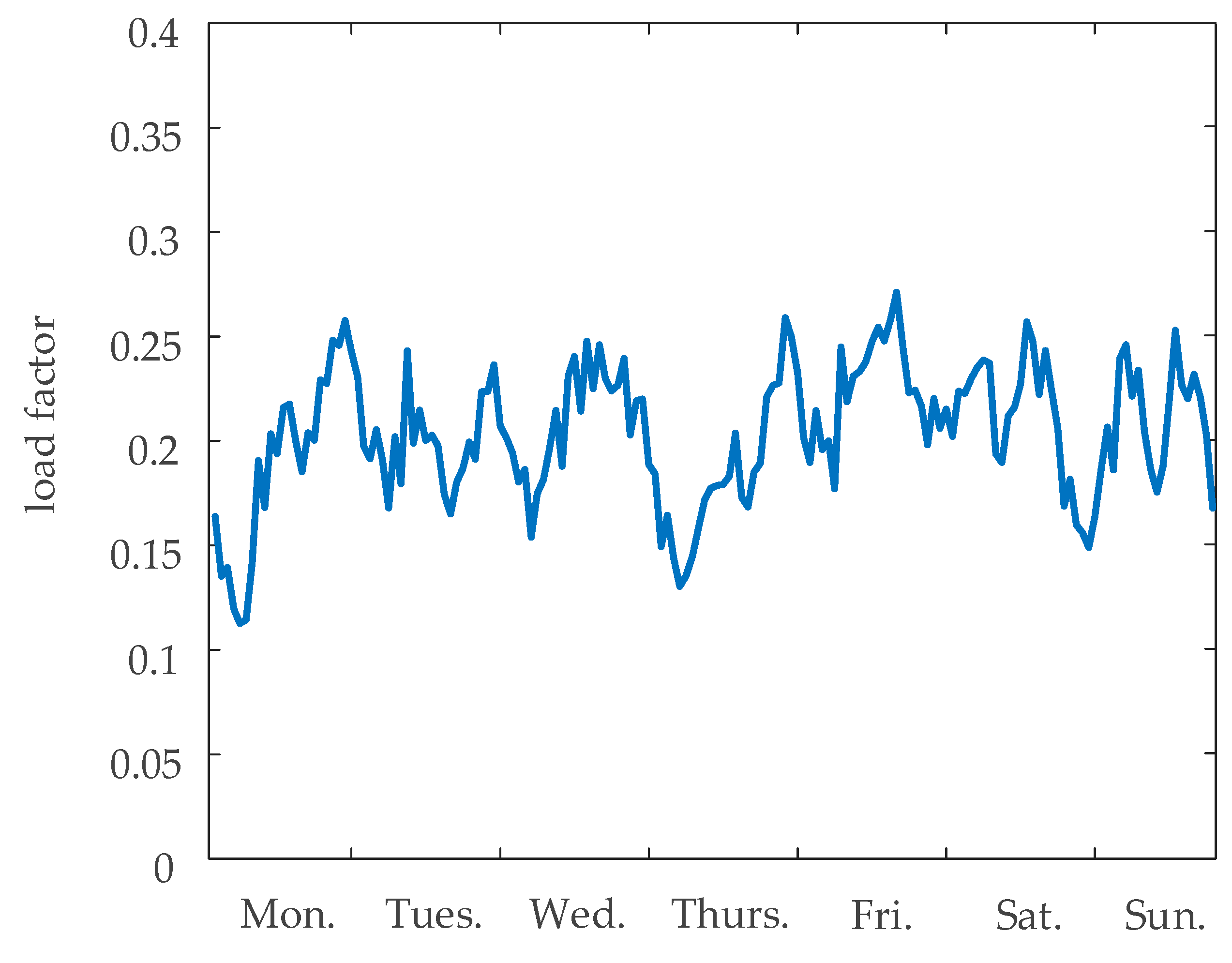
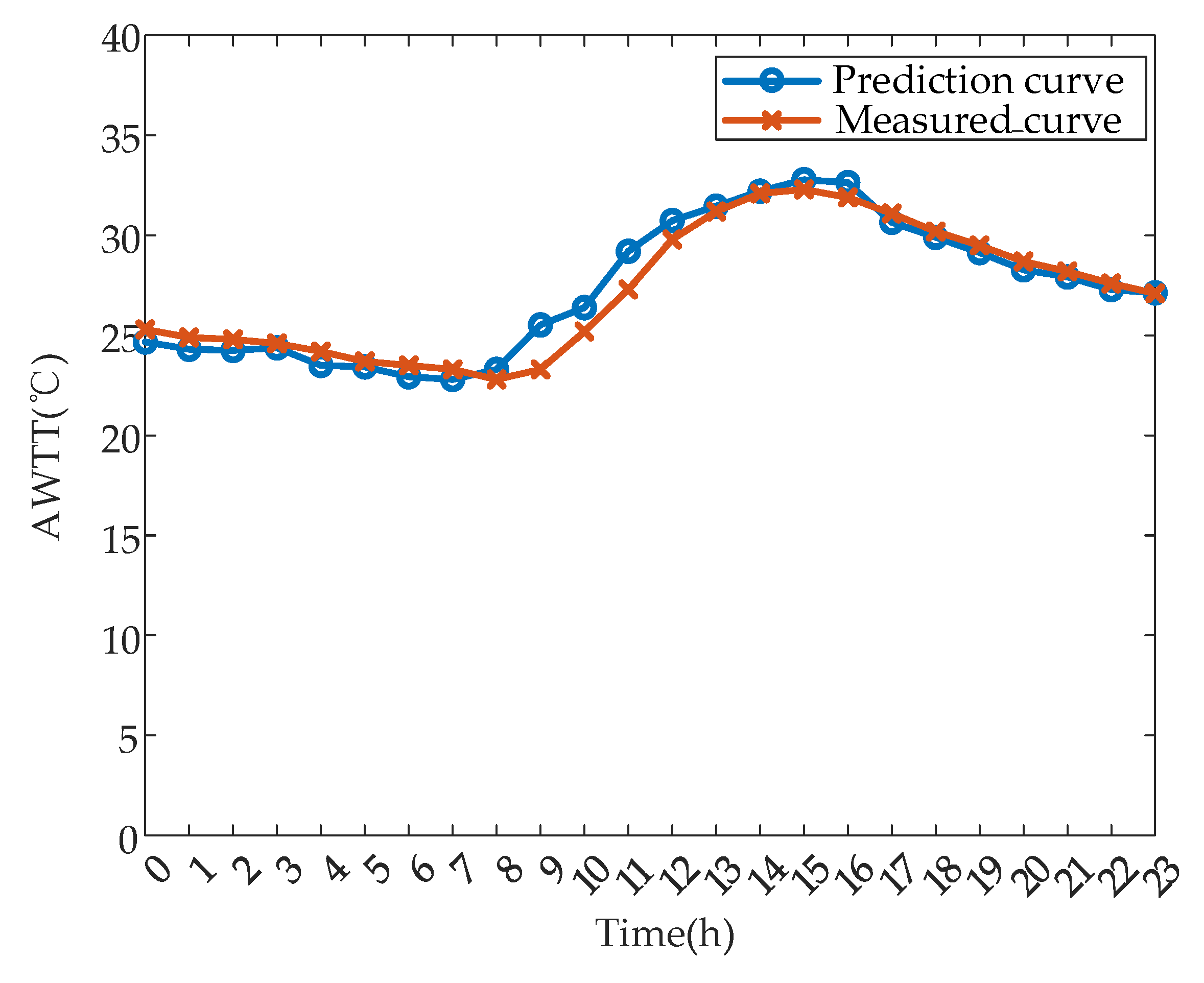
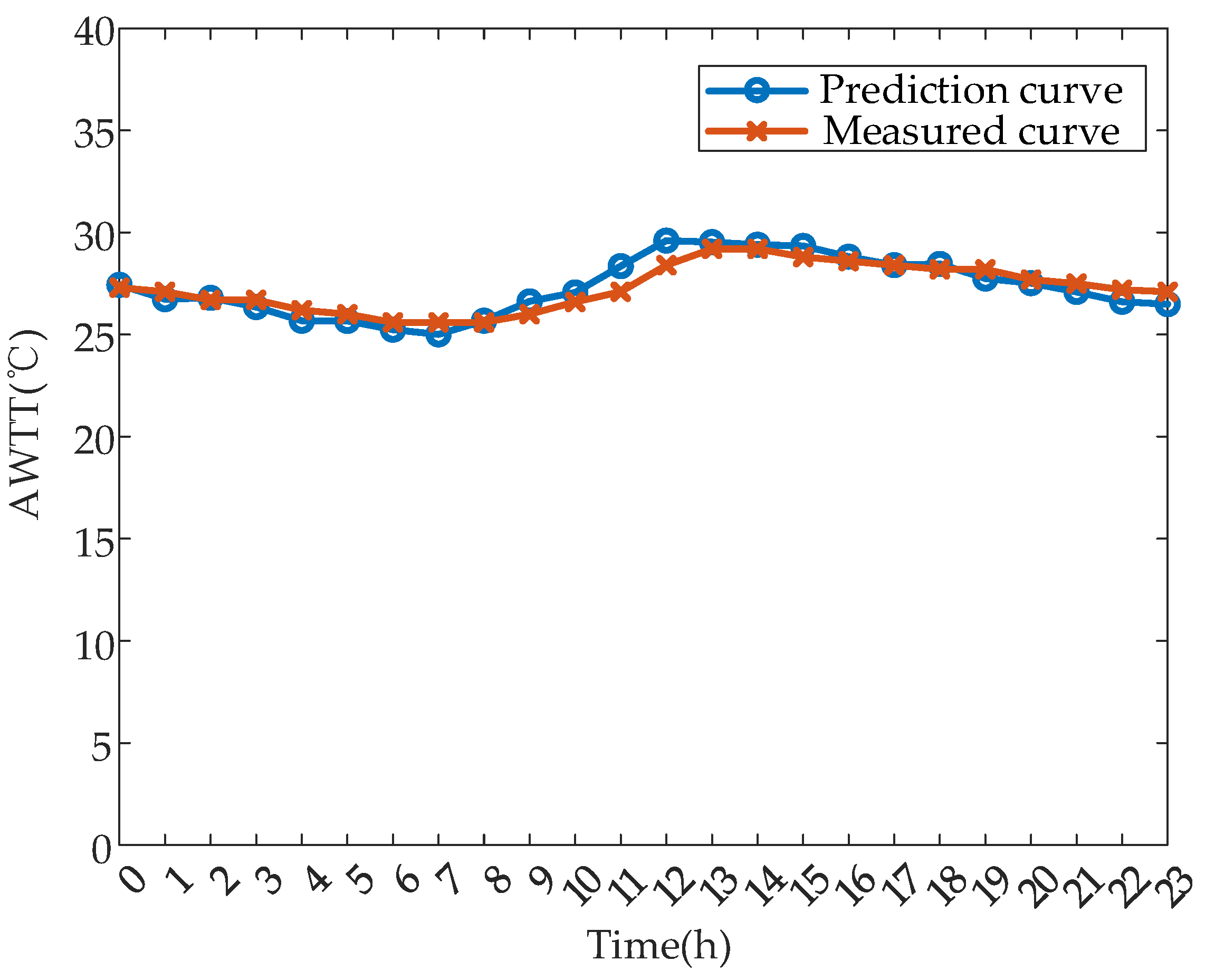
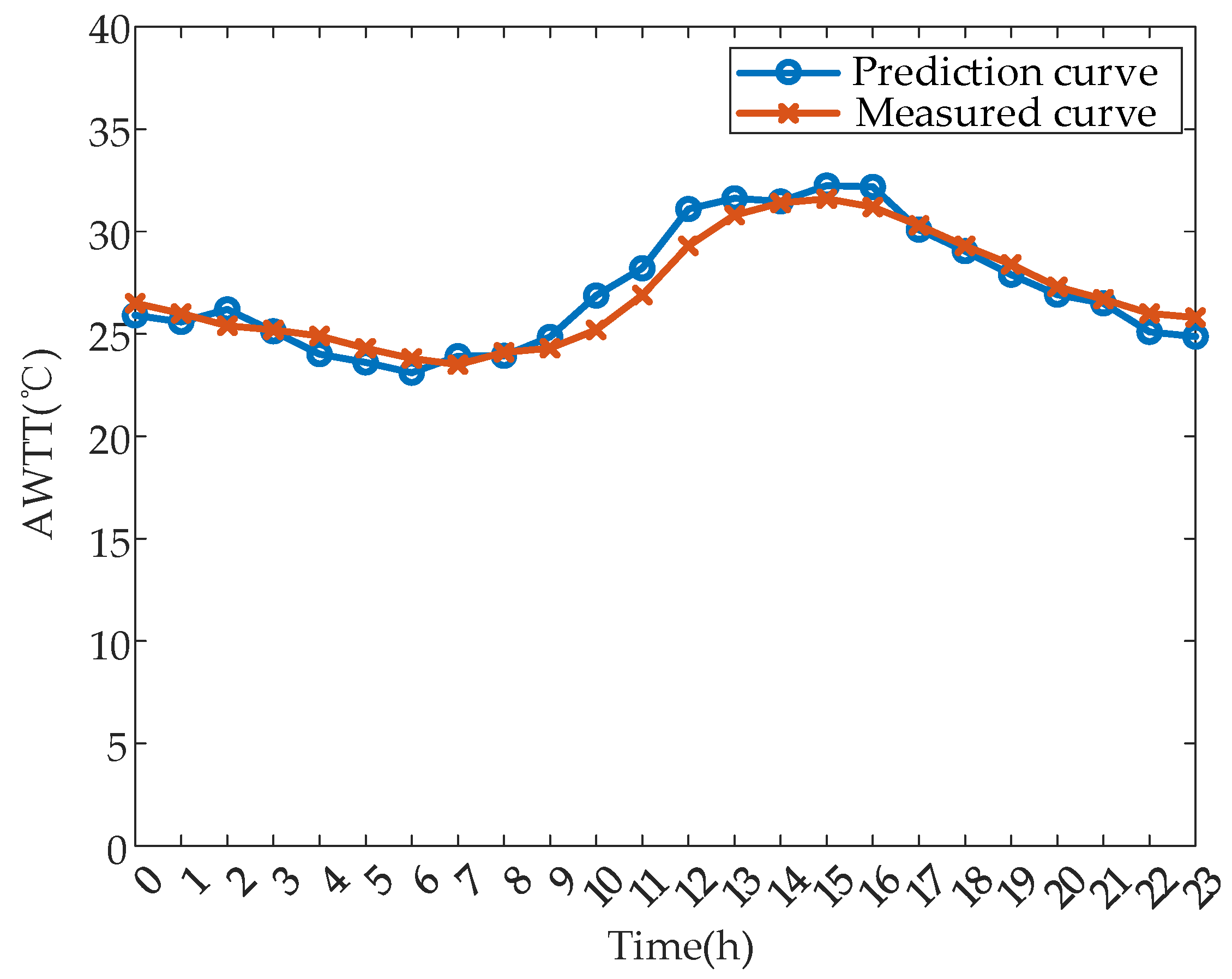


| Method | Inadequacy |
|---|---|
| Empirical thermal model method | Lack of accuracy, dependent on specific conditions |
| Thermal circuit model method | The solving model is relatively complex and computationally heavy |
| Numerical simulation method | High computing resource requirements and complex model building |
| Ambient Temperature | Load Current | Top Oil Temperature | |
|---|---|---|---|
| Ambient temperature | 1 | 0.657 | 0.793 |
| Load current | 0.657 | 1 | 0.724 |
| Top oil temperature | 0.793 | 0.724 | 1 |
| Parametric Index | Value | Parametric Index | Value |
|---|---|---|---|
| Rating capacity | 50,000/50,000/50,000 kVA | Connection group | YNyn0d11 |
| Rating voltage | 110 ± 8 × 1.25%/36.75/10.5 kV | Impedance voltage | 10.3/18.73/6.81% |
| Rating current | 262.4/785.5/2749.3 A | No load current | 0.09% |
| Frequency | 50 Hz | Cooling method | ONAN |
| Number of phases | 3 | Oil surface temperature rise | 55 K |
| Upper oil tank weight | 6700 kg | Oil weight | 20,300 kg |
| Total Variance Interpretation | |||||||||
|---|---|---|---|---|---|---|---|---|---|
| Factor | Initial Eigenvalue | Extract the Sum of Squared Loads | Rotating Load Sum of Squares | ||||||
| Total | Variance % | Accumulate % | Total | Variance % | Accumulate % | Total | Variance % | Accumulate % | |
| 1 | 2.451 | 81.688 | 81.688 | 2.451 | 81.688 | 81.688 | 1.610 | 53.652 | 53.652 |
| 2 | 0.353 | 11.775 | 93.463 | 0.353 | 11.775 | 93.463 | 1.194 | 39.811 | 93.463 |
| 3 | 0.196 | 6.537 | 100.000 | / | / | / | / | / | / |
| Common Factor | Ambient Temperature | Load Current | Top Oil Temperature |
|---|---|---|---|
| 1 | 0.913 | 0.376 | 0.796 |
| 2 | 0.313 | 0.922 | 0.497 |
| Common Factor | Ambient Temperature | Load Current | Top Oil Temperature |
|---|---|---|---|
| 1 | 0.889 | −0.576 | 0.508 |
| 2 | −0.503 | 1.267 | −0.021 |
| Gentle Fluctuation | Moderate Fluctuation | Frequent Fluctuation | |
|---|---|---|---|
| RMSE | 0.2696 | 0.6250 | 0.6441 |
| MAE | 0.399 | 0.6037 | 0.6263 |
| MAPE | 1.47% | 2.31% | 2.33% |
| Textual Method | Hot Circuit Guide Method | Method without Factor Analysis | L-M Method | |
|---|---|---|---|---|
| RMSE | 0.6250 | 14.7216 | 1.9175 | 0.8253 |
| MAE | 0.6027 | 3.1368 | 0.9761 | 0.6819 |
| MAPE | 2.31% | 12.40% | 3.79% | 2.58% |
| R2 | 0.9714 | 0.1835 | 0.8474 | 0.9563 |
Disclaimer/Publisher’s Note: The statements, opinions and data contained in all publications are solely those of the individual author(s) and contributor(s) and not of MDPI and/or the editor(s). MDPI and/or the editor(s) disclaim responsibility for any injury to people or property resulting from any ideas, methods, instructions or products referred to in the content. |
© 2024 by the authors. Licensee MDPI, Basel, Switzerland. This article is an open access article distributed under the terms and conditions of the Creative Commons Attribution (CC BY) license (https://creativecommons.org/licenses/by/4.0/).
Share and Cite
Feng, J.; Feng, Z.; Jiang, G.; Zhang, G.; Jin, W.; Zhu, H. A Prediction Method for the Average Winding Temperature of a Transformer Based on the Fully Connected Neural Network. Appl. Sci. 2024, 14, 6841. https://doi.org/10.3390/app14156841
Feng J, Feng Z, Jiang G, Zhang G, Jin W, Zhu H. A Prediction Method for the Average Winding Temperature of a Transformer Based on the Fully Connected Neural Network. Applied Sciences. 2024; 14(15):6841. https://doi.org/10.3390/app14156841
Chicago/Turabian StyleFeng, Junjie, Ziyu Feng, Guojun Jiang, Guangyong Zhang, Wei Jin, and Huijun Zhu. 2024. "A Prediction Method for the Average Winding Temperature of a Transformer Based on the Fully Connected Neural Network" Applied Sciences 14, no. 15: 6841. https://doi.org/10.3390/app14156841





